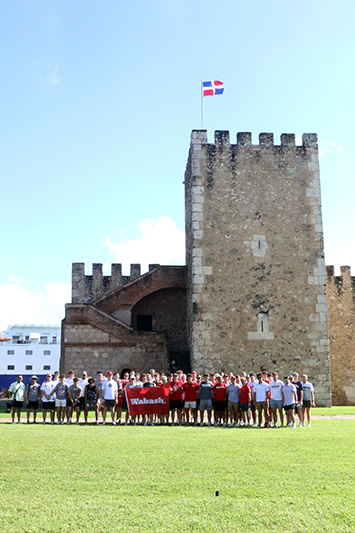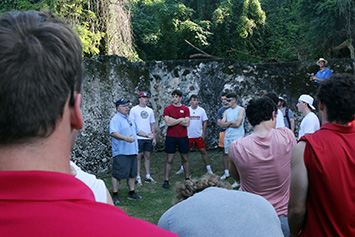SANTO DOMINGO, Dominican Republic – Wednesday was an off day for the Wabash College baseball team, but there was plenty of activity as the group immersed themselves in more than 500 years of history.
About one-third of the team participated in a class this fall led by Spanish Professor Dan Rogers, SPA 312/HSP277: The Dominican Republic and Baseball, and came ready with a knowledge of the history of the island that dates back to Christopher Columbus’ landing in 1492 and colonialization under the occupations that included the Spanish, French, Haitians, and the U.S.
“It was interesting to see how we can relate our academics at Wabash to pretty much anywhere in the world,” said Jackson Woehr ’26 from Whitestown, Indiana. “We we were able to apply what we learned in class and basically inform our teammates who didn't take the class about this history.”
 The squad bused over to Santo Domingo for a morning tour of the Zona Colonial, the oldest part of the Dominican Republic’s capital city, with history that dates back half a millennium. A local tour guide, Juan Sanchez, started the adventure at the Fortaleza Ozama, the oldest fort in North America, which dates back to 1505, and down the Calle de las Damas.
The squad bused over to Santo Domingo for a morning tour of the Zona Colonial, the oldest part of the Dominican Republic’s capital city, with history that dates back half a millennium. A local tour guide, Juan Sanchez, started the adventure at the Fortaleza Ozama, the oldest fort in North America, which dates back to 1505, and down the Calle de las Damas.
Sanchez led the group to stops that included the Panteon de la Patria, an 18th century church that now honors esteemed members of the Dominican Republic’s past. From there, stops included the Palacio de las Gobernadores, Hospital Saint Nicholas of Bari, North America’s first hospital, and ended in Parque Colon, which featured a statue of Columbus and the Nuestra Senora de la Encarnacion, the oldest church in North America and the site of Columbus’ final resting place until 1992.
“Getting to Santo Domingo and to see where Columbus had come and colonized was interesting,” said Braeden Bryant ’25 from Kokomo, Indiana. “It’s crazy to think that the fort and so many other buildings are standing to this day, and that the port is still in use brings so much of what we learned to life.”
The afternoon included a visit to a sugar mill in San Gregorio de Nigua that dates back to the early 1600s, which brought the students back to specific course topics. Prof. Rogers used baseball as a hook to get students to think about issues of colonialism through the Spanish colonial legacy in the Caribbean and Latin America, as well as the U.S. legacy of involvement and imperialism.
“It's one thing to learn it in the classroom, to be interested and even excited about something in the classroom, but when you're here, when you're actually in the place that you’re studying, the connections become much more complex and filled out. Students retain them in ways they wouldn’t if they just had the class or just took a trip.”
As the class learned, sugar was king in the Caribbean in the 16 and 1700s, creating an economic engine that created wealth on the island for both Haiti, ruled by the French, and the Dominican Republic ruled by Spain. Exports like molasses and rum brought untold riches to both crowns.
The sugar mill at San Gregorio tuned out to be a magnificent site for study, allowing Woehr to present material learned in class directly to teammates steps from the main processing area of the mill.
“I felt like I was like teaching my teammates valuable information about the culture and history of the Dominican  Republic,” he said.
Republic,” he said.
The students learned through the class that without sugar there would be no baseball, as many of the professional teams in the D.R. were originally funded by the industry. Founded in the early 1900s, D.R. baseball remains strong, as more than 100 active Major League Baseball players come from the island nation.
Grant Stratton ’25 feels the class prepared him for the games the Little Giants will play here because of his understanding of the history.
“I’ve seen a mutual respect between us and the teams that we’re playing,” said the Jasper, Indiana product. “I didn’t expect the kind of respect that we've been given here, and that was going to be given both ways. That's been special for me.”
Bryant agreed, “We may not speak the same language, but we play the same game and through that, we build relationships. It’s been great to experience.”